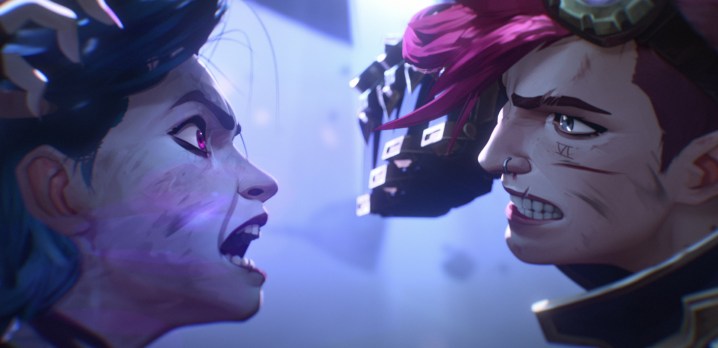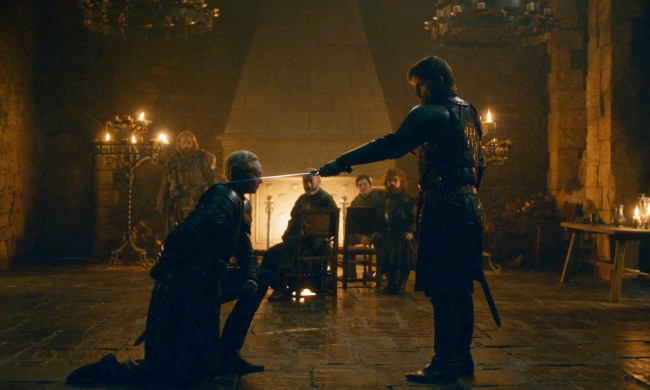Ever since Game of Thrones ended, Hollywood’s biggest streamers and TV networks have worked hard to try and replicate its success. Studios like Netflix and Amazon have invested huge loads of money into high-profile fantasy shows like The Witcher, The Wheel of Time, and The Lord of the Rings: The Rings of Power, while HBO has attempted to keep the Thrones train going with a prequel series, House of the Dragon, and multiple other in-development spinoffs as well.
Try as they might, though, none of these series have been able to successfully recreate the same alchemy of violence, character development, fantasy worldbuilding, and moment-to-moment unpredictability that made Thrones not only so watchable, but downright addictive. The only show that has come even remotely close to doing that is — shockingly enough — Arcane.
On paper, Arcane has little in common with Thrones. It is, first and foremost, animated as opposed to live-action, and while Thrones is based on a collection of sprawling fantasy novels by George R.R. Martin, Arcane is inspired by and set in the League of Legends video game universe. Despite those differences, Arcane offers a viewing experience that is closer to Thrones‘ than any other show you’ll find on TV at the moment. That was true of the show’s first season, which premiered in November 2021, and it is of its long-awaited second, which is set to unfold across several weeks this month on Netflix.

As much as it may come as a surprise to learn given its video game origins, Arcane is set in a fictional world that is visually striking, lived-in, and invitingly complex. At the center of the series is the class divide between the citizens of the rich, clean, upper crust city of Piltover and those who live in the neglected, smog-covered, and dangerous undercity of Zaun. It follows a collection of characters who live in Zaun and Piltover as they find themselves playing different roles in a growing, seemingly inevitable conflict between the two cities. This conflict plays out, much like the battle for the Iron Throne in Game of Thrones, primarily through the relationships between Arcane‘s various characters.
The Netflix series does a good job, particularly in its first season, of balancing its many perspectives and storylines, but none of its threads take precedence over the relationship between Arcane‘s two de facto leads, Violet (Hailee Steinfeld) and Jinx (Fallout star Ella Purnell), two orphaned sisters born in Zaun. Arcane‘s explosive, richly rewarding first season follows Jinx and Violet as a series of shocking tragedies tear them apart and they end up on opposite sides of the show’s Zaun versus Piltover conflict. Vi gradually grows closer to Caitlyn (Katie Leung), a daughter of Piltover royalty, while Jinx forms a seemingly unbreakable bond with Silco (Jason Spisak), Zaun’s top crime boss.
These four characters are surrounded by other, equally important figures, all of whom turn out to have very different roles to play in the escalation of tension between Zaun and Piltover. To say anything about the various directions and turns that both Jinx and Vi’s relationship and Arcane‘s central, twin-city conflict take over the course of its nine-episode first season would be to rob it of much of its power. Arcane proves early on — especially in its gobsmacking third episode — that it isn’t afraid of taking big, landscape-altering swings. It proves itself unwaveringly committed throughout its entire first season to a distinctly Thrones-esque brand of fearless storytelling that makes watching it a uniquely engaging, satisfying, and edge-of-your-seat experience.

Arcane season 2 struggles slightly to balance its many ideas and storylines as well as its first, but the series remains one of the most pulse-pounding, imaginative, and surprising TV titles on the air right now. It is remarkably good at ratcheting up tension at the drop of a hat and finding ways to inject sudden, surprising levels of danger into scenes and episodes that seemed previously innocuous. While the series follows different visual and stylistic rules than Game of Thrones, Arcane thrives on the same political strategizing, ruthlessness, and faction-versus-faction violence that made its HBO predecessor so frequently thrilling.
As shocking and overwhelming as it often feels, the animated series also continues to find the right balance in its action and violence between chaos and fateful tragedy. Certain confrontations, deaths, and alliances may come seemingly out of nowhere, but they always make sense in hindsight and — even more importantly — feel substantial and profound every time they take form onscreen. In case that wasn’t impressive enough, Arcane is so packed full of characters and threats that nary a single episode comes and goes without delivering at least one twist, death, or development that makes your jaw drop and your head whirl.

This kind of sustained, operatic, and visceral drama is incredibly hard to find even in our ever-growing and evolving Prestige TV landscape. It’s what made Game of Thrones a can’t-miss show that hooked millions of viewers for the eight years it was on the air, and it’s what makes Arcane that HBO series’ best, unlikeliest, and yet truest successor to date.
Arcane season 2 premieres in three-episode drops on November 9, November 16, and November 23 on Netflix.



